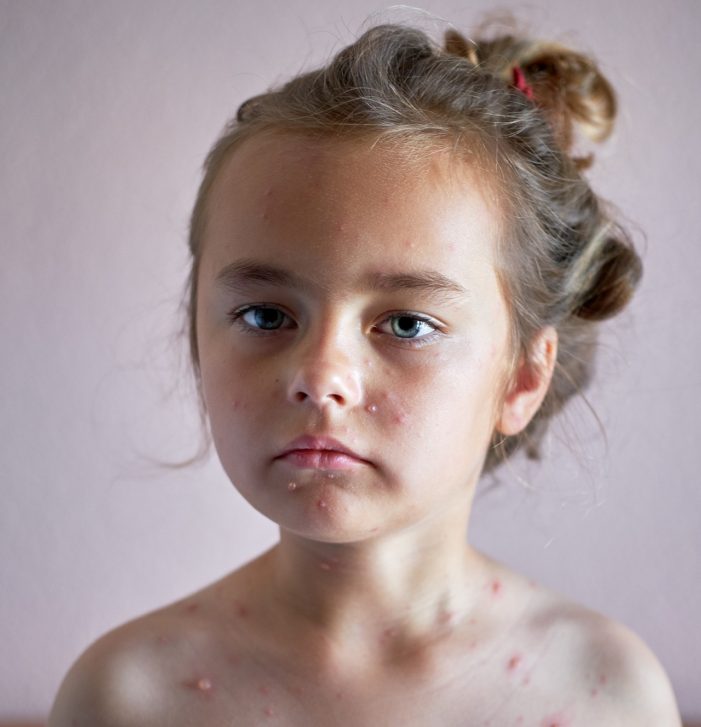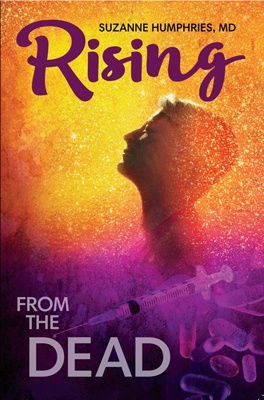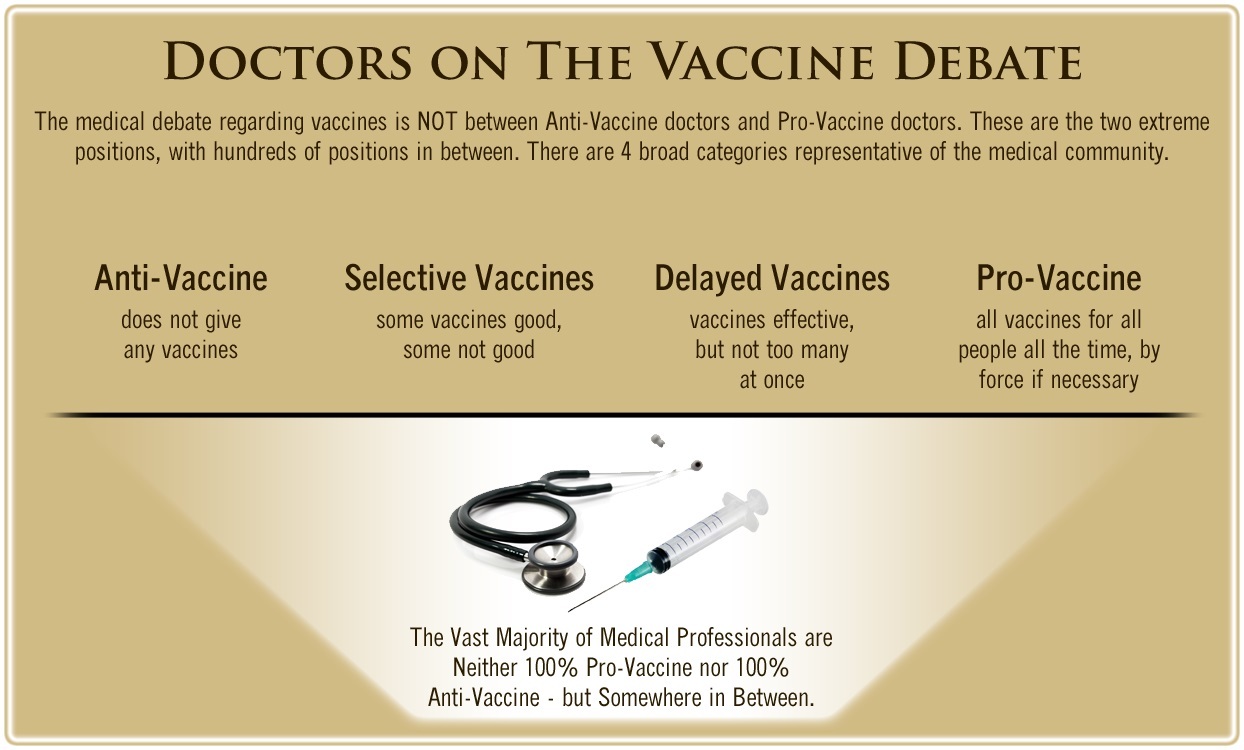
Portrait of a lovely 6-year-old little girl with chickenpox
CDC Accused of Manipulating Shingles Data
by Kate Raines and Barbara Loe Fisher
The Vaccine Reaction
The varicella zoster (chickenpox) virus causes a generally mild and short-lived disease when it occurs in young children under age 12, as it almost always did prior to the live attenuated varicella vaccine being licensed in 1995 and recommended by the Centers for Disease Control and Prevention (CDC) for use by all children.1
Natural chickenpox infection results in long-lasting immunity, while the varicella vaccine’s protection is temporary, leaving vaccinated individuals vulnerable to infection at an older age when chickenpox is much more serious.
After recovery from varicella infection, the virus remains dormant in the system. Before the chickenpox vaccine was widely used, individuals who recovered from chickenpox as children had their immunity asymptomatically boosted by coming in contact with young children infected with chickenpox.2
Without periodic asymptomatic boosting throughout life, however, the dormant varicella zoster virus may reactivate later as herpes zoster (HZ, or shingles), a painful and sometimes persistent blistering rash.
The controversy over varicella vaccine safety and mandates has raged since its introduction in the U.S. nearly 25 years ago.
When it was licensed in 1995, the National Vaccine Information Center (NVIC) questioned the strength of the scientific evidence for safety and effectiveness used by CDC and the American Academy of Pediatrics (AAP) to make a universal use recommendation and argued the vaccine should not be mandated because, in part, universal use of the vaccine could drive chickenpox into older children and adults and raise the risks for shingles later in life.3
CDC Admits the Chickenpox Vaccine Is Reactive, Reactions Underreported
In a 2000 article, the CDC acknowledged that in the first three years of the varicella vaccine’s use between March 1995 and July 1998, the federal Vaccine Adverse Events Reporting System (VAERS) had received 67.5 adverse event reports per 100,000 doses (1 in 1,481 doses), including reports of cases of herpes zoster (shingles).
CDC admitted those adverse event reports were a substantial underestimation of all adverse events that had occurred:
Although the National Childhood Vaccine Injury Act of 1986 (Pub L No 99-660) obliges physicians to submit certain reports, VAERS data are typical of passive drug safety surveillance programs, with case counts that represent unknown but probably highly variable fractions of actual event numbers.4
In a press release, NVIC challenged the CDC’s assertion that varicella vaccine posed minimal risks to children after the VAERS analysis revealed that at least 4 percent of reported adverse events following chickenpox vaccinations were serious, including shock, convulsions, encephalitis, thrombocytopenia and death.
NVIC pointed out that VAERS data included reports of varicella vaccine strain infection and transmission and cases of herpes zoster (shingles) and stated,
The VAERS data has lead to the addition of 17 adverse events to the manufacturer’s product label since the vaccine was licensed for use in 1995, including secondary bacterial infections (cellulitis), secondary transmission (infection of close contacts), transverse myelitis, Guillain Barre syndrome and herpes zoster (shingles).5
Varicella Research Analyst Blows Whistle on CDC Manipulation of Data
Gary S. Goldman, PhD6 served for eight years (from January, 1995 until his resignation in October of 2002) as Research Analyst for the Varicella Active Surveillance Project (VASP) in a cooperative project with the Centers for Disease Control and Prevention (CDC, Atlanta, GA).
Goldman was hired by Vestex Human Resource Systems to conduct studies on the impact of the Universal Varicella Vaccine Program in California’s Antelope Valley region.
Under the auspices of the Los Angeles Department of Health’s Acute Communicable Disease Control unit, the CDC-funded Antelope Valley Varicella Active Surveillance Project (AV-VASP) was charged with monitoring the effects of the varicella (chickenpox) program in a relatively isolated and stable population, primarily from the cities of Lancaster and Palmdale in California’s upper desert area.
When Dr. Goldman was prevented from publishing findings about the negative effects of universal use of varicella zoster vaccination by children, he resigned in 2002. In his resignation letter, he stated,
When research data concerning a vaccine used in human populations is being suppressed and/or misrepresented, this is very disturbing and goes against all scientific norms and compromises professional ethics.
In 2005, Dr. Goldman published a paper giving evidence for the fact that shingles is suppressed naturally in human populations by repeated exposure to natural chickenpox, which provides protective asymptomatic boosting.
He predicted that widespread chickenpox vaccination would lead to a loss of natural immunity and a spike in the incidence of shingles among adults.7
He noted that the pharmacological industry’s expectation was to offset the decrease in circulating chickenpox by vaccinating against shingles, Dr. Goldman said,
Using a shingles vaccine to control shingles epidemics in adults would likely fail because adult vaccination programs have rarely proved successful…There appears to be no way to avoid a mass epidemic of shingles lasting as long as several generations among adults.
In 2006, Goldman published a paper “The Case Against Universal Varicella Vaccination.” He asked,
Is the varicella (chickenpox) vaccine needed? Is it cost effective as a routine immunization for all susceptible children? Or is it more beneficial for the disease to remain endemic so that adults may receive periodic exogenous exposures (boosts) that help suppress the reactivation of herpes zoster (shingles).8
In March 2018, he published an article in Annals of Clinical Pathology,
The US Universal Varicella Vaccination Program: CDC Censorship of Adverse Public Health Consequences.9
In that article he provided evidence to support his allegation that CDC officials manipulated varicella data to affirm the CDC’s support for chickenpox vaccine mandates that that will require a lifetime of expensive vaccine boosters.
He explained the history of the VASP study and data were gathered from 300 participating centers, which included daycare centers, preschools, public and private schools and medical facilities.
By 1999, anecdotal reports from school nurses suggested that the number of herpes zoster (shingles) cases was increasing among children. As there were no baseline figures for comparison, Goldman suggested to principal investigators that shingles statistics should be added to the surveillance criteria.
In what Goldman described as a deliberate “attempt to quash the unwanted outcomes in the years following 2000,” he said it became apparent that the methods for interpretation of data were flawed, skewing CDC and VASP conclusions in favor of the varicella mass vaccination program.
Poor Science and Conflicts of Interest
According to Goldman, among the many ways that CDC officials were able to distort varicella data included the following:
- Averaging rates of chickenpox over years instead of stratifying by year. This had the effect of increasing the apparent impact of the vaccine before it really could have affected incidence in the community and masking the declining efficacy of the vaccine over time.
- Combining the incidence of childhood shingles without differentiating between those who had had natural chickenpox and those who had been vaccinated. This would effectively obscure both the increasing rate of shingles and the importance of asymptomatic immunity boost gained by re-exposure to wild-type chickenpox virus that prevents shingles.
- Directing Goldman to stop his pursuit of shingles trends and, further, prohibiting him from publishing his findings. In a written directive from the County of Los Angeles legal department, which is included in the 2018 article, Goldman was told to “cease and desist in your efforts to publish or disseminate any information gathered as part of your participation on the VASP.”
- Choosing poorly designed studies to support conclusions.
- Actively seeking to discredit Goldman and his research.
- Misleading the public by maintaining that the chickenpox vaccine would be inexpensive, would confer life-long immunity, and there was no immunological link with shingles.
- Tolerating significant financial and personnel conflicts of interest. For example, Goldman points out that Julie Gerberding, who is head of Merck’s Vaccine Division overseeing the marketing of chickenpox and shingles vaccines, was head of the CDC from 2002 to 2009.
Goldman asserted that while CDC continually promotes vaccines as the “safest of all medicines,” and insists that “vaccination relies on science- or evidenced-based medicine,” and fosters “an increasing demand for vaccine mandates,” the CDC is ensuring that the vaccinated public “now requires and will continue to require a lifetime- series of costly booster vaccines.”
He concluded that,
…a combination of financial conflicts of interests, lack of proper controls, and poor methodology in varicella studies commissioned by the CDC often yielded improper or confounded results and conclusions— producing research based on pseudoscience that should more appropriately be relegated to a faith-based belief system rather than the realm of science.
Read the full article at TheVaccineReaction.org.
References:
2 Goldman GS. Universal Varicella Vaccines: Efficacy, Trends and Effects on Herpes Zoster. Int J Toxicology July 1, 2005.
3 National Vaccine Information Center. Varicella Zoster (Chickenpox) Disease and Vaccine and March 1995 Debate on NBC “Today Show.” NVIC.org.
4 Wise RR, Salive ME et al. Postlicensure Safety Surveillance for Varicella Vaccine. JAMA 2000; 284(10): 1271-1279.
5 National Vaccine Information Center. NVIC Challenges VAERS Data of Chickenpox Vaccine Adverse Events. NVIC.org (press release) Sept. 13, 2000.
6 Physicians for Informed Consent. Gary S. Goldman, PhD biography.
7 Goldman, GS. Chicken Pox Vaccine Associated With Shingles Epidemic. Medical Life SciencesSept. 1, 2005.
8 Goldman GS. The Case Against Universal Varicella Vaccination. Int J Toxocol 2006; 25(5).
9 Goldman GS. The US Universal Varicella Vaccination Program: CDC Censorship of Adverse Public Health Consequences. Annals of Clinical Pathology Mar. 31, 2018.
Leaving a lucrative career as a nephrologist (kidney doctor), Dr. Suzanne Humphries is now free to actually help cure people.
In this autobiography she explains why good doctors are constrained within the current corrupt medical system from practicing real, ethical medicine.
One of the sane voices when it comes to examining the science behind modern-day vaccines, no pro-vaccine extremist doctors have ever dared to debate her in public.
Medical Doctors Opposed to Forced Vaccinations – Should Their Views be Silenced?
One of the biggest myths being propagated in the compliant mainstream media today is that doctors are either pro-vaccine or anti-vaccine, and that the anti-vaccine doctors are all “quacks.”
However, nothing could be further from the truth in the vaccine debate. Doctors are not unified at all on their positions regarding “the science” of vaccines, nor are they unified in the position of removing informed consent to a medical procedure like vaccines.
The two most extreme positions are those doctors who are 100% against vaccines and do not administer them at all, and those doctors that believe that ALL vaccines are safe and effective for ALL people, ALL the time, by force if necessary.
Very few doctors fall into either of these two extremist positions, and yet it is the extreme pro-vaccine position that is presented by the U.S. Government and mainstream media as being the dominant position of the medical field.
In between these two extreme views, however, is where the vast majority of doctors practicing today would probably categorize their position. Many doctors who consider themselves “pro-vaccine,” for example, do not believe that every single vaccine is appropriate for every single individual.
Many doctors recommend a “delayed” vaccine schedule for some patients, and not always the recommended one-size-fits-all CDC childhood schedule. Other doctors choose to recommend vaccines based on the actual science and merit of each vaccine, recommending some, while determining that others are not worth the risk for children, such as the suspect seasonal flu shot.
These doctors who do not hold extreme positions would be opposed to government-mandated vaccinations and the removal of all parental exemptions.
In this article, I am going to summarize the many doctors today who do not take the most extremist pro-vaccine position, which is probably not held by very many doctors at all, in spite of what the pharmaceutical industry, the federal government, and the mainstream media would like the public to believe.







Leave a Reply